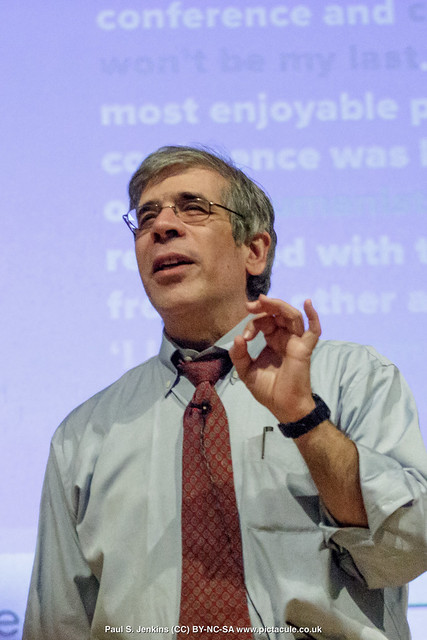For me the stand-out features of
QED this year were the range of speakers and the socialising. Unlike last year I didn't stay at the conference hotel so I had to carry everything for the day with me — which turned out to be a raincoat and a fairly large camera bag. These, I'm happy to report, didn't impede me much.
Like last year I arrived on Friday, catching an earlier train than I'd expected from Euston, and took my time ambling from my lodging to the
Mercure Piccadilly Hotel for a relaxed meal before the
Mixer, which was scheduled for 8 but seemed to be in full swing some time before that. By 8, however, wandering through the packed bar area was like swimming through a sea of skeptic celebrities. It's not called the
Mixer for nothing and is one of the things that makes QED special. Whether or not they had read
Hayley Stevens' blog, many people seemed to be taking her advice about talking to 'strangers'.
As for the event itself, I shall blog about it in short bursts, with photographs:




On Saturday, after
Andy Wilson's official opening — not much more than a welcome and some housekeeping,
Deborah Hyde kicked off with the historical context of the werewolf myth. Being the first speaker at an international conference can be, I imagine, a bit daunting, but Deborah displayed no sign of nerves even as her microphone was replaced or adjusted only seconds into her talk. Last year's first speaker was
Bruce Hood, and I seem to remember he did take a few minutes (though not many) to get into his stride.
Deborah's talk was a new one, though she had given us a sneak preview at
Portsmouth Skeptics in the Pub about a month earlier. In her QED talk she outlined the popular myths, and how it might have been reasonable, given the context and specific examples, to believe that werewolves were real. Bringing the myth down to earth, she included some real wolves.


Next was
Steve Jones, explaining what is meant by natural selection — immediately illustrating the diversity of speakers and topics at this year's QED: from an investigation into the historical basis of popular myths we had moved on to why evolution, as understood by Charles Darwin (though he never used the word in his
Origin of Species), is an undirected process. The example Steve used was the generation of effective shapes for nozzles used in the industrial manufacture of powder, by applying random but small variations to successively more effective shapes, thus refining the efficiency and durability of the nozzles without knowing precisely why they work. It's apparently an engineering technique still in use today.




The last speaker before lunch was
David Aaronovitch. I was particularly keen to hear what he had to say as I attended the
CFI Conspiracy Theories day at Conway Hall, at which David was scheduled to speak, but he had to withdraw due to ill health. So I was not entirely pleased when he began by announcing that his talk would be completely new and unike any of his previous talks. Nevertheless it was lively and off the cuff — conspiracy theories are everywhere so it's not as if there's a dearth of material — and well worth hearing. He spoke mostly about the conspiracy theory that's grown up around the affair of
Dominique Strauss-Kahn — that the allegations against him of attempted rape are part of a sting organised by the French government (or more particularly by factions loyal to
Nicolas Sarkozy).
After an equally lively Q&A session it was time for lunch. Topics had already ranged far and wide. More next time.
(
Click here for part 2.)
This is my 600th blogpost. I thought you'd like to know.

